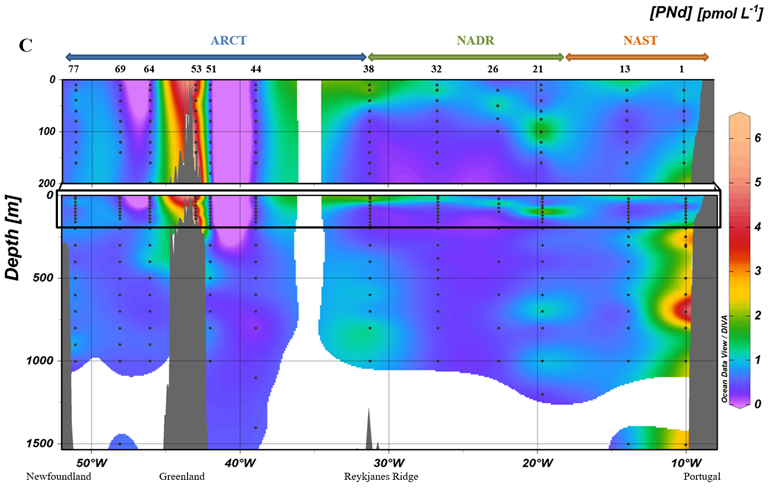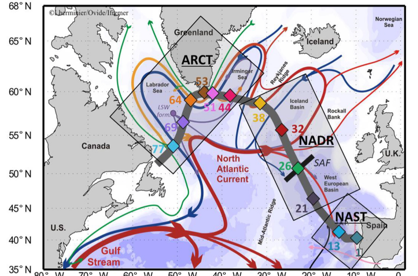Particulate rare earth elements distributions, processes and characterisation of nepheloids in the North Atlantic
Lagarde et al. (2020, see reference below) realised the first basin scale section of particulate rare earth elements (PREE) concentrations across the North Atlantic Ocean. Their results reveal the surprising extension of surface and intermediate nepheloid layers identified by the percentage of lithogenic neodymium (Nd) and reaching the middle of the North Atlantic basin.
This snapshot also enables to highlight that absorption processes are dominant at the surface. Deeper, adsorption become predominant as shown by the holmium/yttrium (Ho/Y) and ytterbium/neodymium (Y/Nd) ratios and a progressive enrichment in cerium (Ce) in particles. In the deepest layers, the two ratios and the Ce positive anomaly are becoming constant, showing an equilibrium between adsorption and dissolution processes. This equilibrium is reached at a greater depth in the eastern basin than in the Labrador Sea. This difference likely reflects the contrasted surface productivity and export rates characterising both areas. Indeed, the Labrador Sea is marked by a strong bloom, high remineralisation rates and thus low export. In this area, heavy rare earth elements concentrations (from terbium, Te, to lutetium, Lu) show a sensitivity to biogenic silica (BSi) concentrations during the diatom bloom that is not observed for light rare earth elements concentrations (from lanthanum, La, to gadolinium, Gd).


Reference:
Lagarde, M., Lemaitre, N., Planquette, H., Grenier, M., Belhadj, M., Lherminier, P., & Jeandel, C. (2020). Particulate rare earth element behavior in the North Atlantic (GEOVIDE cruise). Biogeosciences, 17(22), 5539–5561. DOI: https://doi.org/10.5194/bg-17-5539-2020
Zheng, X.-Y., Plancherel, Y., Saito, M. A., Scott, P. M., and Henderson, G. M. (2016). Rare earth elements (REEs) in the tropical South Atlantic and quantitative deconvolution of their non-conservative behavior, Geochim. Cosmochim. Ac., 177, 217–237, DOI: https://doi.org/10.1016/j.gca.2016.01.018
